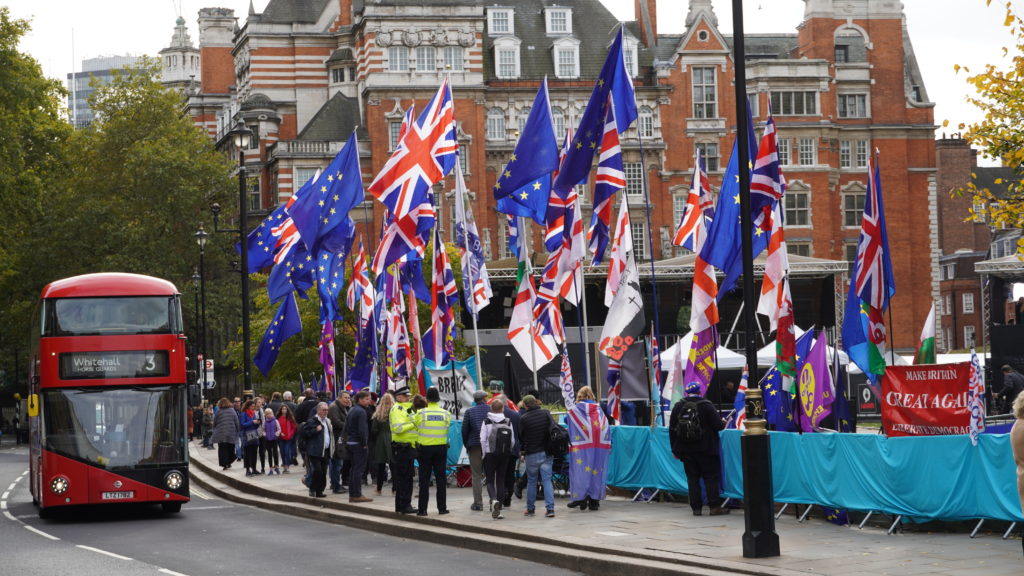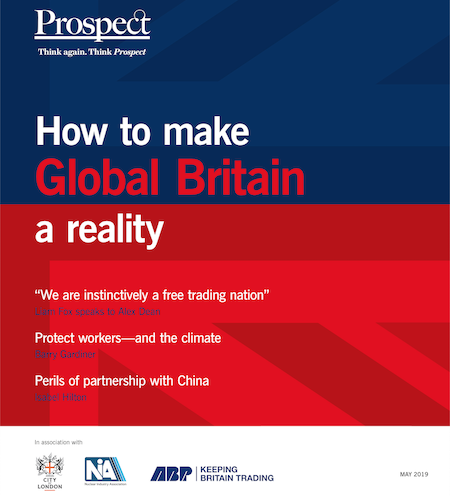The EU-UK trade relationship after Brexit: How does Boris’s deal compare to Theresa’s deal?
Email Subscription
To stay informed about Trade-Up’s activities and projects and receive our blog via email as soon as it is posted, please subscribe below:
Lars Hoelgaard is Partner at Trade-Up Consulting Brussels
The UK Parliament has now agreed to hold elections on the 12 of December. This creates considerable uncertainty as what happens with Boris Johnson’s Brexit deal with the EU 27 which recently found a majority in the House of Commons. Something that Theresa May never achieved with her deal. The outcome of the elections will determine whether the deal can be formalized before the new deadline of the 31 of January 2020 when the UK is set to leave the EU. At this stage we can only speculate as to how the next House of Commons will be composed. None the less given that the deal has received political support it is relevant to compare Boris Johnson’s deal with Theresa May’s deal. There are wide-circulated claims that the May and the Johnson deals are 95 % identical but they differ on some important and substantial aspects.
Both ’Brexit deals’ consist of the Withdrawal Agreement (WA) accompanied by the Political Declaration (PD). It is the Political Declaration that provides the framework for the future trade relationship. The PD has been amended several times during the discussions.
The earlier versions of the PD left almost everything open for the future negotiation. The outcome could have ranged from a very soft Brexit like Norway+ (Customs Union) to a hard Brexit (Canada style FTA).
The problem with the May deal was that it operated under the illusion that the outcome of a unique UK-EU Trade deal could avoid a hard border between Ireland and Northern Island. If, however the trade deal could not assure the absence of border checks, then the so-called ‘Alternative Arrangements’ i.e. a technological solution or Max Fac could be introduced. This was another illusion since a difference in legislation and standards between two countries, in this case the EU 27 and the UK, will always lead to border checks. The application of the Backstop provision was therefore inevitable. It was the decision of Theresa May (“no UK Prime Minister could allow for a difference of treatment between Northern Island and the rest of the UK” i.e. Great Britain) to reject the application of the Backstop for Northern Island only, as Chief EU negotiator Michel Barnier had originally proposed. Applying the Backstop to the whole of the UK, would resolve the issue of different treatment between the UK and Northern Ireland but would have led to a quasi-permanent customs union between the UK and the EU.

So, the May deal, although open on paper with respect to the future trade relationship between the UK and the EU, de facto would have excluded an independent UK trade policy, contrary to May’s assurances, and would most likely have led to a soft Brexit due to its inherent contradictions. The Brexiteers rightly saw this and therefore strongly opposed the May deal as breaching one their most treasured Red lines.
With the deal Boris Johnson has struck with the EU 27, the Irish Backstop has been replaced with a semi-permanent solution where Northern Ireland formally stays in the UK custom union but de facto in the EU Customs Union (CU) and follows EU Single Market (SM) rules. Border controls on the island of Ireland are prevented and instead moved to the Irish Sea between Great Britain and Northern Ireland. Getting rid of the Backstop thus opens the door for the UK to strike its own trade deals with third countries – a sine qua non for the Hard Brexiteers.
The Irish question sorted
The main advantage of the Johnson deal is that the ‘Irish question’ has been permanently solved subject to being regularly confirmed by the ‘Consent clause’ in the Protocol. The ‘All Island Economy’ is saved and the integration between the North and the South of the island will be further consolidated since the Northern Irish economy will be even more integrated into the Irish economy. It is difficult to imagine that the Northern Island assembly will backtrack on the arrangements which will be up for discussion for the first time four years after the UK has left the EU.
Global Britain with an independent UK trade policy
The Johnson deal prioritizes the Brexiteers’ vision of ‘Global Britain’ based on an independent UK trade policy, potentially putting the UK Union under strain. It is for this reason that the DUP opposes the Johnson deal and might now be ready to support the May deal. Whereas the May deal would have resulted in a Soft Brexit, the Johnson deal prepares for a Hard Brexit or even a later No Deal Brexit.

This difference of objective is reflected in the last version of the PD which has been amended again to align with Boris Johnson’s strategy of the UK becoming “Global Britain” and freely negotiate its own trade deals. The PD states at the beginning: “an ambitious, broad, deep and flexible partnership across trade and economic cooperation with a comprehensive and balanced Free Trade Agreement at its core”. The subsequent language leaves the door open to a more fundamental relationship, but the direction of travel is obvious. This is quite different from Theresa May’s perspective. She rejected early on the idea of a UK-EU FTA based on something like the EU-Canada FTA model as being insufficient.
The future ‘Level Playing Field’ between the UK and the EU revisited
In addition, it should be noted that the so-called ‘Level Playing Field’ provisions have been removed from the WA and are now only referred to in the PD. Although media have speculated about the significance of this change, in the end the EU message remains the same. The more the UK in the future diverges (i.e. with lower or different standards) from the Single Market standards the more frictionless trade is endangered. Diverging standards will trigger difficult negotiations on possible mutual recognition or equivalency to ensure unrestricted access. Border controls and paperwork will be necessary. The softer the Brexit the easier the access and vice versa.
No Deal at the end of 2020?
There is an interesting detail in the WA Agreement that might reflect Boris Johnson’s true intentions. The May deal was first put to the UK Parliament at the end of 2018 allowing for a two-year transition period, thereby ensuring the status quo in trade between the UK and the EU until the end of 2020. It would have been logical to move this date by a year to 2021 to allow for a two-year negotiation for a future comprehensive FTA Agreement between the EU and the UK. The WA Agreement states that a two-year prolongation of the transition period is possible. However, Boris Johnson has said clearly that the UK does not envisage an extension. The deadline for asking for an extension of the transition period is end of July 2020.
The fact that Boris Johnson has not asked for a change of the date and wants to keep the transition period in all circumstances to one year, raises the suspicion that the negotiation with the EU will not be done in good faith with the objective of obtaining a ‘deep and comprehensive’ trade deal. Negotiating an FTA deal in one year is simply impossible. Experience shows that these are complex negotiations stretching over several years. So instead of having a “No deal” Brexit now, there is a real risk that it will be postponed till the 1/1/2021.
The Pandora Box of a UK-US trade deal
In the meantime, it will free the hands of Boris Johnson to negotiate free trade agreements with other third countries. Normally, no third country will be ready to enter into a trade agreement with the UK without knowing the exact terms of future trade between the UK and the EU.
However, from the start Donald Trump made it clear that he is ready to negotiate a “beautiful trade deal” between the US and the UK. The message is that this could happen very quickly thereby providing Boris Johnson and the Brexiteers with a big political win and vindication of their line. Such a new UK-US trade deal might well enter into force on the 1/1/2021 in coincidence with the end of the transition period!

The US strategy is not only to increase market access to the UK, but also indirectly to put pressure on the EU. To get such a deal, the UK will have to make concessions on US agricultural exports of hormone treated beef and chicken carcasses subjected to chlorine washing as well as other issues like US participation in UK public procurement. It is highly unlikely that the US Congress will accept a deal without such provisions. This has been on the agenda from the US side since the hormone ban in the EU entered into force on the 1 January 1989. The US thus sees a trade deal with the UK as a first step in breaking down the EU opposition to hormone beef and chlorinated chicken imports. As for the UK as the weaker partner it is unlikely that it will win major concessions on US market access for UK services.
This puts the UK in a dilemma. Making such concessions immediately triggers problem with the UK’s exports to the EU as well as to Northern Ireland, increasing the split between Great Britain and Northern Island. Such products will immediately be hit by the Protocol on Northern Island and not be allowed to go from Great Britain to NI.
Accepting such a deal with the US will complicate further the UK negotiations with the EU and put the UK Union under threat.
EU remains major trading partner
Yet, the fact remains that the EU is by far the most important trading partner for the UK. UK global trade may be further developed but cannot substitute regional trade in Europe. As experience shows regional trade is the predominant trade pattern all over the world. Even within the EU and the EU Single Market trade remains mainly regional. Any plan to become a global trading partner without a regional trade base will not succeed. Not to mention joint EU-UK interests originating from geographical proximity in the areas of security, migration, energy and transport.
How far will the UK move from a ‘soft’ to a ‘hard’ Brexit?
At this stage it remains open how far the present UK government has moved from a ‘Soft’ to a ‘Hard’ Brexit. The UK elections will have an impact on the future government positioning. Depending on the priorities of a future UK Government the outcome of the EU-UK trade negotiations can be anything between a close or a distant ‘Singapore on the Thames’ type deal with corresponding effects on trade. The EU’s intentions are clearer, namely to maintain as close a relationship as possible to safeguard trade and just in time production and integrated supply chain management. The majority of UK and EU companies and traders favor a soft Brexit to limit damage to their economic activities. The more access to each other’s’ market gets restricted, the less the interest to strike a deal.
Conclusion
However, as matters stand there is a real risk of a No Deal Brexit scenario materializing on the 1/1/2021, simply by default with time running out on EU-UK trade negotiations.
